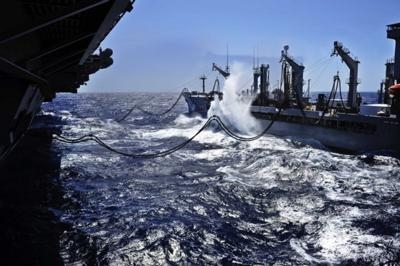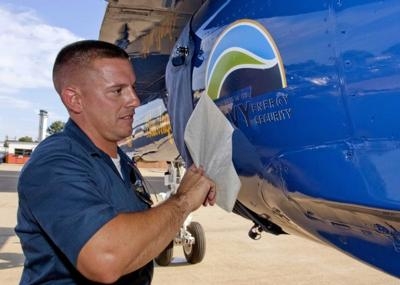Mon, Jul 23, 2012
Aircraft Flying On A Camelina Oil-Jet Fuel Blend
NAVAIR’s fuels team is helping the Navy move closer to its goal of deploying a “fleet of ships powered by biofuels.” The fuels team developed a 50/50 blend of camelina oil and JP-5 jet fuel for aircraft and a 50/50 blend of F-76 petroleum and algae-based biofuel to power the ship engines being used during the biennial Rim of the Pacific, or RIMPAC, exercise.

The fuel delivery is part of the Navy's Great Green Fleet demonstration, which allows the Navy to test, evaluate and demonstrate the cross-platform utility and functionality of advanced biofuels in an operational setting.
The Green Strike Group demonstration will use 900,000 gallons of the blend during the exercise. The demonstration is a critical component of the Navy's Test and Qualification process, said NAVAIR fuels team lead Rick Kamin. The exercise is used for approving fuels produced from renewable sources for inclusion in the Navy's JP-5 (shipboard aviation fuel) and F-76 (marine diesel fuel) specifications, Kamin said. “This demonstration provides an opportunity to have the fleet personnel assess the performance of tactical Naval Fuels [JP-5 and F-76] produced from renewable sources in an operational environment,” Kamin said. “Fuel performance will be evaluated for the entire path of the fuel, from shore base storage to the end consumer -- ship or aircraft.”
Begun as an annual exercise in 1971, RIMPAC is a multinational maritime exercise that takes place in and around the Hawaiian Islands. RIMPAC 2012 began June 29 and is scheduled to run through Aug. 3. It features 22 nations, 40 surface ships, six submarines, more than 200 aircraft and 25,000 personnel.

Biofuel was first used by non-test and evaluation pilots last September when the Blue Angels flight demonstration team used it during the NAS Patuxent River Air Expo. The six F/A-18 jets performed their flight demonstration without any problems, an official with the team said.
“To put it into perspective, I fly this airplane about 400 times a year, so I am very in tune with the airplane itself,” Navy Capt. Greg McWherter, Blue Angels commanding officer, said in an interview last September. “For me to get in there and see almost no difference between the biofuel and our normal JP variant is amazing. The fuel performed flawlessly and we are very excited about demonstrating that capability. I wouldn’t fly with my wingmen if I didn’t have 100 percent confidence that it was good.”
For flight demonstration, the Navy requires the 50/50 camelina/JP-5 biofuel be a drop-in replacement for petroleum-based fuel; have no notable operational differences; and be able to be mixed or alternated with petroleum fuel. It also must require no changes to the Navy’s existing fuel storage or transfer infrastructure.
The demonstration of the “Green Strike Group” is a precursor to the secretary of the Navy’s 2016 goal of deploying a fully operational “Great Green Fleet.”
(Photos provided by the U.S. Navy)
More News
Also: 787-Billion Pax, Ryanair Buying Chinese, Ballooning HoF, ERAU MX Competition An NTSB Preliminary report is shedding some light on the Rob Holland tragedy. And there now seems>[...]
Also: Tricky Golf Course Deadstick, Textron Special Olympics, Artemis II, FlightSimExpo! Stratolaunch conducted the second successful launch and recovery of its Talon-A2 autonomous>[...]
Also: Rotax Service Instruction, LAA Jabiru Alert, New AMA Boss, FlightSimExpo ANN’s Jim Campbell got an hour in the SLEEK Blackshape Prime last week along with a chance to w>[...]
“Secretary Duffy’s plan cements America as a global leader in aviation, investing in both technology and the air traffic control workforce to enhance U.S. aviation safe>[...]
Witnesses Described That The Glider Pitched Up Before Entering A Nose Low, Left Descending Turn Analysis: The 84-year-old pilot was being towed for takeoff in his glider when the a>[...]
 Airborne 05.05.25: NTSB Holland Prelim, Airlines v Tariffs, $$$ For ATC
Airborne 05.05.25: NTSB Holland Prelim, Airlines v Tariffs, $$$ For ATC Airborne 05.07.25: Talon A-2 Hypersonic, FIFI Under Repair, Spirit Furloughs
Airborne 05.07.25: Talon A-2 Hypersonic, FIFI Under Repair, Spirit Furloughs Airborne Affordable Flyers 05.08.25: Blackshape Test, Risen, Alto NG Sells Out
Airborne Affordable Flyers 05.08.25: Blackshape Test, Risen, Alto NG Sells Out Aero-News: Quote of the Day (05.11.25)
Aero-News: Quote of the Day (05.11.25) NTSB Final Report: Schleicher Alexander GMBH & CO ASH 26 E
NTSB Final Report: Schleicher Alexander GMBH & CO ASH 26 E




